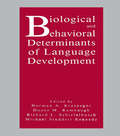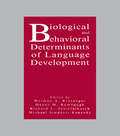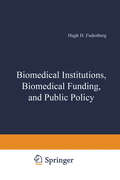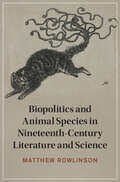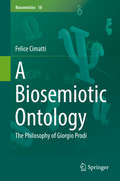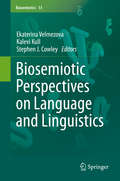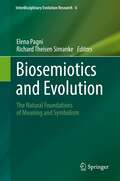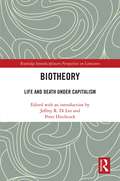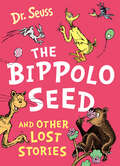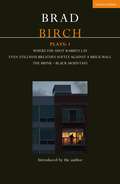- Table View
- List View
Biography: An Historiography
by Melanie NolanBiography: An Historiography examines how Western historians have used biography from the nineteenth century to the present – considering the problems and challenges that historians have faced in their biographical practice systematically. This volume analyses the strategies and methods that historians have used in response to seven major issues identified over time to do with evidence, including but not limited to the problem of causation, the problem of fact and fiction, the problem of other minds, the problem of significance or representativeness, the problems of perspective, both macro and micro, and the problem of subjectivity and relative truth. This volume will be essential for both postgraduates and historians studying biography.
Biography: An Historiography
by Melanie NolanBiography: An Historiography examines how Western historians have used biography from the nineteenth century to the present – considering the problems and challenges that historians have faced in their biographical practice systematically. This volume analyses the strategies and methods that historians have used in response to seven major issues identified over time to do with evidence, including but not limited to the problem of causation, the problem of fact and fiction, the problem of other minds, the problem of significance or representativeness, the problems of perspective, both macro and micro, and the problem of subjectivity and relative truth. This volume will be essential for both postgraduates and historians studying biography.
Biography in Early Modern France, 1540-1630: Forms and Functions
by Katherine MacDonald"When the famous Royal Professor of Philosophy and Eloquence Petrus Ramus (1515-1572) gave a lecture, one of his most promising pupils stood by, ready to tug on his coat if he made a mistake. That pupil was Ramus's future biographer, the much less famous Nicolas de Nancel (1539-1610), who recounted this anecdote in hisVita Rami (1599). Nancel's insertion of himself into his life of Ramus is typical of early modern biographies of men of letters. As biographer, the humanist man of letters situated himself within the same cultural field as his subject, thereby accrediting himself as a fellow man of letters by his display of humanistic competence. The first study of monograph lives of men of letters in sixteenth-century France, this ground-breaking book offers valuable insights into biography's role as a form of social and cultural negotiation geared to advance the biographer's career."
Biography in Early Modern France, 1540-1630: Forms and Functions
by Katherine MacDonald"When the famous Royal Professor of Philosophy and Eloquence Petrus Ramus (1515-1572) gave a lecture, one of his most promising pupils stood by, ready to tug on his coat if he made a mistake. That pupil was Ramus's future biographer, the much less famous Nicolas de Nancel (1539-1610), who recounted this anecdote in hisVita Rami (1599). Nancel's insertion of himself into his life of Ramus is typical of early modern biographies of men of letters. As biographer, the humanist man of letters situated himself within the same cultural field as his subject, thereby accrediting himself as a fellow man of letters by his display of humanistic competence. The first study of monograph lives of men of letters in sixteenth-century France, this ground-breaking book offers valuable insights into biography's role as a form of social and cultural negotiation geared to advance the biographer's career."
Biography of an Industrial Town: Terni, Italy, 1831–2014 (Palgrave Studies in Oral History)
by Alessandro PortelliA pioneering work in oral history, this book tells the story of the rise and fall of the industrial revolution and the apogee and crisis of the labor movement through an oral history of Terni, a steel town in Central Italy and the seat of the first large industrial enterprise in Italy. This story is told through a combination of stories, songs, myths and memories from over 200 voices of five generations, woven with a wealth of archival material.
Biolinguistic Investigations and the Formal Language Hierarchy (Routledge Leading Linguists)
by Juan UriagerekaThis volume collects some of Juan Uriagereka’s previously published pieces and presentations on biolinguistics in recent years in one comprehensive volume. The book’s introduction lays the foundation for the field of biolinguistics, which looks to integrate concepts from the natural sciences in the analysis of natural language, situating the discussion within the minimalist framework. The volume then highlights eight of the author’s key papers from the literature, some co-authored, representative of both the architectural and evolutionary considerations to be taken into account within biolinguistic research. The book culminates in a final chapter showcasing the body of work being done on biolinguistics within the research program at the University of Maryland and their implications for interdisciplinary research and future directions for the field. This volume is essential reading for students and scholars interested in the interface between language and the natural sciences, including linguistics, syntax, biology, archaeology, and anthropology.
Biolinguistic Investigations and the Formal Language Hierarchy (Routledge Leading Linguists)
by Juan UriagerekaThis volume collects some of Juan Uriagereka’s previously published pieces and presentations on biolinguistics in recent years in one comprehensive volume. The book’s introduction lays the foundation for the field of biolinguistics, which looks to integrate concepts from the natural sciences in the analysis of natural language, situating the discussion within the minimalist framework. The volume then highlights eight of the author’s key papers from the literature, some co-authored, representative of both the architectural and evolutionary considerations to be taken into account within biolinguistic research. The book culminates in a final chapter showcasing the body of work being done on biolinguistics within the research program at the University of Maryland and their implications for interdisciplinary research and future directions for the field. This volume is essential reading for students and scholars interested in the interface between language and the natural sciences, including linguistics, syntax, biology, archaeology, and anthropology.
Biological and Behavioral Determinants of Language Development
by Norman A. Krasnegor Duane M. Rumbaugh Richard L. Schiefelbusch Michael Studdert-KennedyThis book presents a current, interdisciplinary perspective on language requisites from both a biological/comparative perspective and from a developmental/learning perspective. Perspectives regarding language and language acquisition are advanced by scientists of various backgrounds -- speech, hearing, developmental psychology, comparative psychology, and language intervention. This unique volume searches for a rational interface between findings and perspectives generated by language studies with humans and with chimpanzees. Intended to render a reconsideration as to the essence of language and the requisites to its acquisition, it also provides readers with perspectives defined by various revisionists who hold that language might be other than the consequence of a mutation unique to humans and might, fundamentally, not be limited to speech.
Biological and Behavioral Determinants of Language Development
by Norman A. Krasnegor Duane M. Rumbaugh Richard L. Schiefelbusch Michael Studdert-KennedyThis book presents a current, interdisciplinary perspective on language requisites from both a biological/comparative perspective and from a developmental/learning perspective. Perspectives regarding language and language acquisition are advanced by scientists of various backgrounds -- speech, hearing, developmental psychology, comparative psychology, and language intervention. This unique volume searches for a rational interface between findings and perspectives generated by language studies with humans and with chimpanzees. Intended to render a reconsideration as to the essence of language and the requisites to its acquisition, it also provides readers with perspectives defined by various revisionists who hold that language might be other than the consequence of a mutation unique to humans and might, fundamentally, not be limited to speech.
Biological and Behavioral Determinants of Language Development
by Norman A. Krasnegor Duane M. Rumbaugh Richard L. Schiefelbusch Michael Studdert-Kennedy Esther ThelenThis book presents a current, interdisciplinary perspective on language requisites from both a biological/comparative perspective and from a developmental/learning perspective. Perspectives regarding language and language acquisition are advanced by scientists of various backgrounds -- speech, hearing, developmental psychology, comparative psychology, and language intervention. This unique volume searches for a rational interface between findings and perspectives generated by language studies with humans and with chimpanzees. Intended to render a reconsideration as to the essence of language and the requisites to its acquisition, it also provides readers with perspectives defined by various revisionists who hold that language might be other than the consequence of a mutation unique to humans and might, fundamentally, not be limited to speech.
Biological and Behavioral Determinants of Language Development
by Norman A. Krasnegor Richard L. Schiefelbusch Michael Studdert-Kennedy Duane M. RumbaughThis book presents a current, interdisciplinary perspective on language requisites from both a biological/comparative perspective and from a developmental/learning perspective. Perspectives regarding language and language acquisition are advanced by scientists of various backgrounds -- speech, hearing, developmental psychology, comparative psychology, and language intervention. This unique volume searches for a rational interface between findings and perspectives generated by language studies with humans and with chimpanzees. Intended to render a reconsideration as to the essence of language and the requisites to its acquisition, it also provides readers with perspectives defined by various revisionists who hold that language might be other than the consequence of a mutation unique to humans and might, fundamentally, not be limited to speech.
Biomateriomics (Springer Series in Materials Science #165)
by Steven W. Cranford Markus J. BuehlerBiomateriomics is the holistic study of biological material systems. While such systems are undoubtedly complex, we frequently encounter similar components -- universal building blocks and hierarchical structure motifs -- which result in a diverse set of functionalities. Similar to the way music or language arises from a limited set of music notes and words, we exploit the relationships between form and function in a meaningful way by recognizing the similarities between Beethoven and bone, or Shakespeare and silk. Through the investigation of material properties, examining fundamental links between processes, structures, and properties at multiple scales and their interactions, materiomics explains system functionality from the level of building blocks. Biomateriomics specifically focuses the analysis of the role of materials in the context of biological processes, the transfer of biological material principles towards biomimetic and bioinspired applications, and the study of interfaces between living and non-living systems. The challenges of biological materials are vast, but the convergence of biology, mathematics and engineering as well as computational and experimental techniques have resulted in the toolset necessary to describe complex material systems, from nano to macro. Applying biomateriomics can unlock Nature’s secret to high performance materials such as spider silk, bone, and nacre, and elucidate the progression and diagnosis or the treatment of diseases. Similarly, it contributes to develop a de novo understanding of biological material processes and to the potential of exploiting novel concepts in innovation, material synthesis and design.
Biomedical Institutions, Biomedical Funding, and Public Policy
by H. HughFudenbergThe world is on the threshold of a great new industrial revolution, a 1 scientific-industrial revolution. Recombinant DNA technology and hybridoma technology ("monoclonal antibodies") have already pro vided unique investment opportunities for venture capitalists. Hence published reports of biomedical research are no longer restricted to scientific journals, but now appear regularly not only in weekly news 2 magazines like Time and U. S. News & World Report,3 but also in the financial sections of The New York Times,4 The Wall Street Journal,S 6 8 Business Week, Fortune,7 and The Economist, as well as in such stock 9 market advisory publications as New Issues and Inc. (The Magazine for Growing Companies). 10 These publications now appear to be as impor tant to biomedical scientists in keeping abreast of new scientific devel opments in biotechnology as is Current Contents. (The costs of health cost provision and of fundamental biomedical research are now also being followed by such media. ) Conversely, Wall Street financial bro kers increasingly no longer confine their reading to economic journals but are also perusing Nature,ll Science,12 and Science N 13 for infor ews mation on both fiscal and scientific advances in these areas. It is obvious that the information explosion in biotechnology is crossing traditional boundaries (e. g. , ref. 14). This volume is the second of several that are intended to inform both the biomedical community and interested intelligent laymen of the political and economic implications of biomedical research.
Biomedical Scientists and Public Policy
by Vijaya L. Melnick H. HughFudenbergThis volume brings together the views of authors involved in many aspects of biomedicine-from research on basic biology to clinical invest igation of the causes and treatment of human disease to hospital adminis tration ·to health care planning on the state and Federal levels to Con gressionallegislation covering biomedical research, medical education, the development of medical technology, and the delivery of health care. The purpose is not to present a "party line" representing a consensus of these often divergent viewpoints, and we do not suggest that we have found solutions to the many problems encountered in the interaction of scientists, administrators, legislators, and the recipients of health care. These articles are intended primarily to communicate to both biomedical scientists and intelligent laymen the processes, social and political as well as scientific, whereby biomedical science advances, and the need for biomedical scientists to take an interest and initiative not only in scientific research but also in research on health care delivery and in related public issues before the legislative and administrative branches of government.
Biopolitics and Animal Species in Nineteenth-Century Literature and Science (Cambridge Studies in Nineteenth-Century Literature and Culture)
by null Matthew RowlinsonPrinciples of species taxonomy were contested ground throughout the nineteenth century, including those governing the classification of humans. Matthew Rowlinson shows that taxonomy was a literary and cultural project as much as a scientific one. His investigation explores animal species in Romantic writers including Gilbert White and Keats, taxonomies in Victorian lyrics and the nonsense botanies and alphabets of Edward Lear, and species, race, and other forms of aggregated life in Darwin's writing, showing how the latter views these as shaped by unconscious agency. Engaging with theoretical debates at the intersection of animal studies and psychoanalysis, and covering a wide range of science writing, poetry, and prose fiction, this study shows the political and psychic stakes of questions about species identity and management. This title is part of the Flip it Open Programme and may also be available Open Access. Check our website Cambridge Core for details.
Biopolitics and Memory in Postcolonial Literature and Culture
by Michael R. GriffithsFrom the Truth and Reconciliation Commission in South Africa to the United Nations Permanent Memorial to the Victims of Slavery and the Transatlantic Slave Trade, many worthwhile processes of public memory have been enacted on the national and international levels. But how do these extant practices of memory function to precipitate justice and recompense? Are there moments when such techniques, performances, and displays of memory serve to obscure and elide aspects of the history of colonial governmentality? This collection addresses these and other questions in essays that take up the varied legacies, continuities, modes of memorialization, and poetics of remaking that attend colonial governmentality in spaces as varied as the Maghreb and the Solomon Islands. Highlighting the continued injustices arising from a process whose aftermath is far from settled, the contributors examine works by twentieth-century authors representing Asia, Africa, North America, Latin America, Australia, and Europe. Imperial practices throughout the world have fomented a veritable culture of memory. The essays in this volume show how the legacy of colonialism’s attempt to transform the mode of life of colonized peoples has been central to the largely unequal phenomenon of globalization.
Biopolitics and Memory in Postcolonial Literature and Culture
by Michael R. GriffithsFrom the Truth and Reconciliation Commission in South Africa to the United Nations Permanent Memorial to the Victims of Slavery and the Transatlantic Slave Trade, many worthwhile processes of public memory have been enacted on the national and international levels. But how do these extant practices of memory function to precipitate justice and recompense? Are there moments when such techniques, performances, and displays of memory serve to obscure and elide aspects of the history of colonial governmentality? This collection addresses these and other questions in essays that take up the varied legacies, continuities, modes of memorialization, and poetics of remaking that attend colonial governmentality in spaces as varied as the Maghreb and the Solomon Islands. Highlighting the continued injustices arising from a process whose aftermath is far from settled, the contributors examine works by twentieth-century authors representing Asia, Africa, North America, Latin America, Australia, and Europe. Imperial practices throughout the world have fomented a veritable culture of memory. The essays in this volume show how the legacy of colonialism’s attempt to transform the mode of life of colonized peoples has been central to the largely unequal phenomenon of globalization.
Biosemiotic Literary Criticism: Genesis and Prospectus (Biosemiotics #24)
by W. John ColettaThis volume is based to a large extent on the understanding of biosemiotic literary criticism as a semiotic-model-making enterprise. For Jurij Lotman and Thomas A. Sebeok, “nature writing is essentially a model of the relationship between humans and nature” (Timo Maran); biosemiotic literary criticism, itself a form of nature writing and thus itself an ecological-niche-making enterprise, will be considered to be a model of modeling, a model of nature naturing. Modes and models of analysis drawn from Thomas A. Sebeok and Marcel Danesi’s Forms of Meaning: Modeling Systems Theory and Semiotic Analysis as well as from Timo Maran’s work on “modeling the environment in literature,” Edwina Taborsky’s writing on Peircean semiosis, and, of course, Jesper Hoffmeyer’s formative work in biosemiotics are among the most important organizing elements for this volume.
A Biosemiotic Ontology: The Philosophy of Giorgio Prodi (Biosemiotics #18)
by Felice CimattiGiorgio Prodi (1928-1987) was an important Italian scientist who developed an original philosophy based on two basic assumptions: 1. life is mainly a semiotic phenomenon; 2. matter is somewhat a semiotic phenomenon.Prodi applies Peirce's cenopythagorean categories to all phenomena of life and matter: Firstness, Secondness, and Thirdness. They are interconnected meaning that the very ontology of the world, according to Prodi, is somewhat semiotic. In fact, when one describes matter as “made of” Firstness and Secondness, this means that matter ‘intrinsically’ implies semiotics (with Thirdness also being present in the world).At the very heart of Prodi’s theory lies a metaphysical hypothesis which is an ambitious theoretical gesture that places Prodi in an awkward position with respect to the customary philosophical tradition. In fact, his own ontology is neither dualistic nor monistic. Such a conclusion is unusual and weird, but much less unusual in present time than it was when it was first introduced. The actual resurgence of various “realisms” make Prodi’s semiotic realism much more interesting than when he first proposed his philosophical approach. What is uncommon, in Prodi perspective, is that he never separated semiotics from the materiality of the world. Prodi does not agree with the “standard” structuralist view of semiosis as an artificial and unnatural activity. On the contrary, Prodi believed semiosis (that is, the interconnection between Firstness, Secondness and Thirdness) lies at the very bottom of life. On one hand, Prodi maintains a strong realist stance; on the other, a realism that includes semiosis as ‘natural’ phenomena. This last view is very unusual because all forms, more or less, of realism exclude semiosis from nature but they frequently “reduce” semiosis to non-semiotic elements. According to Prodi, semiosis is a completely natural phenomenon.
Biosemiotic Perspectives on Language and Linguistics (Biosemiotics #13)
by Ekaterina Velmezova Kalevi Kull Stephen J. CowleyThe first international volume on the topic of biosemiotics and linguistics. It aims to establish a new relationship between linguistics and biology as based on shared semiotic foundation.
Biosemiotics and Evolution: The Natural Foundations of Meaning and Symbolism (Interdisciplinary Evolution Research #6)
by Elena Pagni Richard Theisen SimankeThis book reviews the evolution of Biosemiotics and gives an outlook on the future of this interdisciplinary new discipline. In this volume, the foundations of symbolism are transformed into a phenomenological, technological, philosophical and psychological discussion enriching the readers’ knowledge of these foundations. It offers the opportunity to rethink the impact that evolution theory and the confirmations about evolution as a historical and natural fact, has had and continues to have today. The book is divided into three parts:Part I Life, Meaning, and InformationPart II Semiosis and EvolutionPart III Physics, medicine, and bioenergetics It starts by laying out a general historical, philosophical, and scientific framework for the collection of studies that will follow. In the following some of the main reference models of evolutionary theories are revisited: Extended Synthesis, Formal Darwinism and Biosemiotics. The authors shed new light on how to rethink the processes underlying the origins and evolution of knowledge, the boundary between teleonomic and teleological paradigms of evolution and their possible integration, the relationship between linguistics and biological sciences, especially with reference to the concept of causality, biological information and the mechanisms of its transmission, the difference between physical and biosemiotic intentionality, as well as an examination of the results offered or deriving from the application in the economics and the engineering of design, of biosemiotic models for the transmission of culture, digitalization and proto-design. This volume is of fundamental scientific and philosophical interest, and seen as a possibility for a dialogue based on theoretical and methodological pluralism. The international nature of the publication, with contributions from all over the world, will allow a further development of academic relations, at the service of the international scientific and humanistic heritage.
Biotheory: Life and Death under Capitalism (Routledge Interdisciplinary Perspectives on Literature)
by Jeffrey R. Di Leo Peter HitchcockForged at the intersection of intense interest in the pertinence and uses of biopolitics and biopower, this volume analyzes theoretical and practical paradigms for understanding and challenging the socioeconomic determinations of life and death in contemporary capitalism. Its contributors offer a series of trenchant interdisciplinary critiques, each one taking on both the specific dimensions of biopolitics and the deeper genealogies of cultural logic and structure that crucially inform its impress. New ways to think about biopolitics as an explanatory model are offered, and the subject of bios (life, ways of life) itself is taken into innovative theoretical possibilities. On the one hand, biopolitics is addressed in terms of its contributions to forms and divisions of knowledge; on the other, its capacity for reformulation is assessed before the most pressing concerns of contemporary living. It is a must read for anyone concerned with the study of bios in its theoretical profusions.
Biotheory: Life and Death under Capitalism (Routledge Interdisciplinary Perspectives on Literature)
by Schulz Jeffrey R. Di Leo Peter HitchcockForged at the intersection of intense interest in the pertinence and uses of biopolitics and biopower, this volume analyzes theoretical and practical paradigms for understanding and challenging the socioeconomic determinations of life and death in contemporary capitalism. Its contributors offer a series of trenchant interdisciplinary critiques, each one taking on both the specific dimensions of biopolitics and the deeper genealogies of cultural logic and structure that crucially inform its impress. New ways to think about biopolitics as an explanatory model are offered, and the subject of bios (life, ways of life) itself is taken into innovative theoretical possibilities. On the one hand, biopolitics is addressed in terms of its contributions to forms and divisions of knowledge; on the other, its capacity for reformulation is assessed before the most pressing concerns of contemporary living. It is a must read for anyone concerned with the study of bios in its theoretical profusions.
The Bippolo Seed and Other Lost Stories
by null Dr. SeussListen along as comedy legend and children’s author David Walliams reads these seven laugh-out-loud Dr. Seuss stories. Enjoy this brilliant ebook anytime, anywhere. These amazing stories are full of typical Seuss humour, rhyme and rhythm and are all beautifully illustrated. They include 'The Bippolo Seed,' in which a scheming cat leads an innocent duck to make a bad decision; 'The Rabbit, the Bear, and the Zinniga-Zanniga,' about a rabbit who is saved from a bear via a single eyelash; 'Gustav the Goldfish,' about a fish that grew and grew; 'Tadd and Todd,' a tale about twins; 'Steak for Supper,' about fantastic creatures who follow a boy home in anticipation of a steak dinner; 'The Strange Shirt Spot,' about a spot of dirt that gets everywhere; and 'The Great Henry McBride,' about a boy whose far-flung career fantasies were bested only by those of Dr. Seuss himself. The perfect book for any Seuss fan, young or old! With his unique combination of hilarious stories, zany pictures and riotous rhymes, Dr. Seuss has been delighting young children and helping them learn to read for over fifty years. Creator of the wonderfully anarchic Cat in the Hat, and ranked among the UK’s top ten favourite children’s authors, Dr. Seuss is a global best-seller, with over half a billion books sold worldwide.
Birch Plays: Where the Shot Rabbits Lay; Even Stillness Breathes Softly Against a Brick Wall; The Brink; Black Mountain (Contemporary Dramatists)
by Brad BirchBirch Plays: 1 celebrates the work of Welsh writer Brad Birch. Winner of the 2016 Harold Pinter Commission for the Royal Court Theatre Birch is the writer in residence at Undeb Theatre and is currently on attachment at the Royal Shakespeare Company and the National Theatre. His work has been produced by the Royal Court, Sherman Cymru, Theatre503 and the National Youth Theatre as well as around the world in Russia, the USA, Italy, Germany and Spain.Bringing together plays from throughout his career to date this remarkable collection includes a selection of previously published and unpublished works along with an introduction by the author.Where the Shot Rabbits Lay (Royal Court, 2012) - "There are some lovely grace notes in Brad Birch's intimate father-son tale" (Time Out London)Even Stillness Breathes Softly Against a Brick Wall (Soho Theatre, 2013) - "a lovely play of sharp edges, falsehoods and unsaid thoughts, twinning great humour and strong emotion throughout" (WhatsOnStage)The Brink (Orange Tree, 2016) - "short, sharp, shockingly entertaining" (The Guardian)Black Mountain (Paines Plough Roundabout, Edinburgh, 2017) - "This is a real rarity: a psychological thriller that feels psychologically accurate – and it actually thrills too." (Scotsman)




